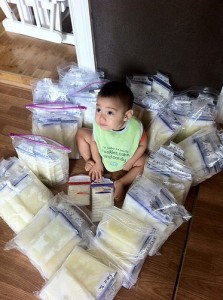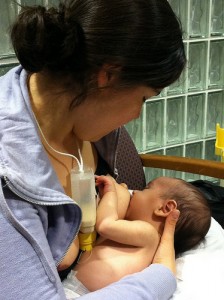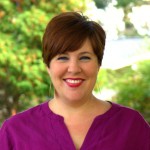August 14, 2013
Supporting Families in Milk Sharing; What are the Responsibilities of the Childbirth Professional
By: Sharon Muza, BS, LCCE, FACCE, CD/BDT(DONA), CLE | 0 Comments
By Amber McCann, IBCLC
Today's post is written by Amber McCann, IBCLC. Amber is one of the two keynote speakers at the upcoming Lamaze International Annual Conference in New Orleans this October. Science & Sensibility readers had a chance to "meet" Amber in yesterday's interview on the blog. Today Amber shares her perspective on discussing milk sharing with the families we work with. To learn more about Amber and what she will be speaking about at the conference, please click here. See you in New Orleans! Let the good times roll for safe and healthy birth!

© http://flic.kr/p/cYv62C
Almost a year ago, I wrote a post on my blog entitled "Supporting Families in Milk Sharing as an International Board Certified Lactation Consultant". In it, I laid out some of my key beliefs, not only about the value of human milk for babies, but about what my profession dictates I do when presented with the opportunity to educate and inform about human milk sharing. I've come to think that these same obligations are universal to all of those who encounter and advise pregnant families, including childbirth educators. My core belief is this:
I believe that parents are capable of making the choices that are best for themselves and their families.
It is my job to make sure they have all of the information to do so.
In my work, and I'm sure the same is true for most of you, I encounter families every day who, for a variety of reasons, need to supplement their baby's nutrition with something other than milk directly from the mother's breast. There are many options available to them including pumping and feeding their own milk, supplementing with the milk of another human mother, formulas made from cow's milk, formulas made from soy, formulas that are pre-digested, etc. No option should be assumed as the RIGHT option for any particular family. By educating and providing information, we can help parents make the choices that work best for their own families.
The World Health Organization, it its Global Strategy for Infant and Young Child Feeding, says,
"for those few health situations where infants cannot, or should not, be breastfed, the choice of the best alternative - expressed breast milk from an infant's own mother, breast milk from a healthy wet-nurse or human-milk bank, or a breastmilk substitute...depends on individual circumstance."
In our current environment, actual wet-nursing is deemed by many to be too inconvenient, too intimate, and - if you will - too gross. But what about the sharing of breast milk from one mother to another? Since most mothers have access to a breast pump, it has become increasingly easy to package milk in a shareable form. Many groups, such as Human Milk 4 Human Babies (HM4HB), have formed in the past years to provide a space for families in need to connect with families who want to give. Feeding a child the milk from a mother not their own is a viable solution to some family's supplementation needs. Can we, as birth and breastfeeding professionals, share this option with the families I serve? I answer with a strong and firm YES.
When I began providing information on milk sharing with my colleagues and clients, I wasn't quite prepared for the strong backlash I would receive. "What if a baby gets sick and dies?!?" Despite the fact that many in my field have participated in milk sharing themselves, there is a palpable fear, on the professional level, that one bad outcome from milk sharing would halt all of the positive momentum that breastfeeding is gaining in our culture. I even had one colleague say to me, "These women...these women who are doing this are going to hurt or even kill their babies." I maintain that they are simply trying to provide the food that they were designed to eat.
But, what about the RISKS? Wouldn't I be putting the lives of the babies I serve at risk if I offer milk sharing as an option? I maintain that there is nothing in life that is without risk. Is milk sharing risk free? Absolutely not. There are also risks to breastfeeding and formula feeding. Dr. Karleen Gribble and Dr. Bernice Hausman discuss these concerns in their paper Milk Sharing and Formula Feeding: Infant Feeding Risks in Comparative Perspective. In it, they explore the issues of contamination of milk with pathogens, chemicals, concerns with milk collection and storage hygiene. They also discuss the risks to formula use that are not present when feeding human milk. In addition, there is a section devoted to the risk of HIV from the use of shared milk. I strongly advise every professional encountering and advising new mothers, as well as any family we are working with, to read this paper and discuss their concerns. Drs. Gribble and Hausman conclude that "instead of proscribing peer-to-peer milk sharing, health authorities should provide parents with guidance on how to manage and minimize the risks of sharing human milk."
How do childbirth professionals instruct and inform new families about the risks and benefits of consuming or donating shared milk? How do we advise families to mitigate those risks?
For recipients: When someone I work with is in need of milk and is considering milk sharing, I strongly encourage them to think about whether people they already know might be willing to donate. They also might explore location-based online milk sharing groups (like HM4HB), and then groups that facilitate broader-range sharing and the shipping of donor breast milk (like MilkShare). I do not condone the sale and purchase of breastmilk and I strongly encourage those I work with to not consider it as an option.
No matter where the milk is coming from, I encourage those considering milk sharing to thoroughly research what sorts of screening they consider essential (such as blood work from pregnancy and questionnaires about lifestyle choices such as alcohol and medication use). It is important that both parties have clear expectations about what their milk sharing arrangement looks like. At no point should I, as an IBCLC, nor you, as childbirth professional, engage with the recipient family as a "milk broker." The family is fully responsible for finding, contacting and making arrangements with their milk donors. Our role with milk recipients is only to provide information and resources.
Of note, it is always my hope that supplementation of any type can be eliminated or minimized because of an increase in a mother's own ability to make milk. The milk sharing community is often particularly in tune with the need and desire of mothers to work hard to rebuild their milk supply. Some families get a donor and a cheerleader-in-one! Many mothers feed donor milk through the use of a supplemental feeder, which can help mothers to produce increasing amounts of their own milk by stimulating the breast while delivering the supplement. There are many stories of those who were in need of donor milk, were able to rebuild their supply and then donate milk back into the community.
For donors: I often have mothers, in their glee at how much milk their body is making, send me an email saying they "had so much we had to dump it down the sink." Nothing strikes panic into the heart of a lactation professional faster! If a mother tells me, as her lactation consultant, that she has more milk than she knows what to do with, I offer her information about donation. I share with her the options of contributing to a HMBANA milk bank, donating directly to another family or sharing her milk with a for-profit milk bank. (Though I have significant ethical concerns about these banks, I do share the information so that they can make the best decision for their family.)
I stress to the family that the milk they have is first and foremost for their own baby. I know that many families feel incredibly proud and thankful to be able to share of their excess. I encourage families to participate openly and honestly in all screening with their recipient family and to make sure that both parties have clear expectations about what their milk sharing arrangement looks like. At no point should I, as an IBCLC, nor you, as a childbirth professional, engage with the recipient family as a "milk broker." The family is fully responsible for finding, contacting and making arrangements with their milk donors. Our role with milk recipients is only to provide information and resources.
An obvious question in all of this is why wouldn't a mother in need of additional milk for her child simply obtain it from a milk bank? Then we wouldn't be talking about risks of disease and contamination. In an ideal world, families would be able to receive ALL the milk they need from milk banks. Milk banks would be located in every community and have an unending supply of milk. I believe this can be a reality. I believe that there can be plenty of milk available to every baby that needs it. As a passionate advocate for getting human milk to human babies, Emma Kwasnica says, "milk is a free flowing resource."

© http://flic.kr/p/cQxLBy
Unfortunately, in the United States, this isn't yet the reality. As a nation, we need to drastically increase the number of milk banks and the amount of human donor milk available. The Human Milk Banking Association of North America (HMBANA) currently has 12 active banks. These banks do incredible work and, rightly so, their priority is on making sure that the MOST CRITICAL babies receive the milk that they process. For these little ones, having access to human milk can be, quite literally, a matter of life and death. Often, several milk banks, including those in Indiana and Utah, issue pleas in the media for increased donations because their supplies are low. It is absolutely essential that these babies be the first to have access to processed donor milk.
Does every baby need its milk processed by a milk bank focused on the needs of vulnerable infants? For the most fragile babies, the complex processes of a milk bank (milk pooling, pasteurizing, and testing) are critical. The needs of a healthy term newborn are different. I liken it to this: If you had a dear friend who had recently received an organ transplant, you would do everything within your power to visit with them in a healthy manner by scrubbing arms and hands and wearing a mask. But, if that same friend has just gone through a "healthy" event, like birth, you would simply wash your hands. Different circumstances require different levels of caution.
Where does that leave healthy babies? In my practice, I see many mothers who, for of a variety of physical, emotional or circumstantial reasons don't make the milk that their baby needs. At some milk banks, families of healthy babies can sometimes purchase donor milk but it is typically in limited quantities, and only available when supplies exist to meet the need of critical infants first. While the cost associated is reasonable, considering the cost of processing by the milk bank, it is often prohibitive to the families in need.
Is the only option for these families infant formula? I have every confidence that the human milk banking advocates all over the globe would affirm the belief that all babies have the right to human milk. I think that milk banking and milk sharing CURRENTLY serve very different populations of babies. Above all, my loyalties are not to milk banks or the milk sharing movement, but rather to babies and their families. There is room in the community for both methods of getting human milk to human babies.
I have been privileged to work with a number of families who were involved in milk sharing, both on the donor side and on the recipient side. I have seen milk donations have a significant impact on the health of a child. I have seen milk donations foster community that might not have happened otherwise. I have seen milk donations turn grief into hope. I have seen milk donations empower families and save babies' lives.
Milk sharing is not the right choice for every mother in need. Milk sharing is not the right choice for every mother who desires to donate her milk. But for many families, milk sharing facilitates health, community building, and an opportunity to reclaim the breastfeeding experience for those whose journey didn't go as they planned.
Again, I affirm that parents are capable of making the choice that is best for their families.
It is my job to make sure they have all the information to do so.
References
Gribble KD, Hausman BL. Milk sharing and formula feeding: Infant feeding risks in comparative perspective. AMJ 2012, 5, 5, 275-283.http//dx.doi.org/10.4066/AMJ.2012.1222.
World Health Organisation Staff. (2003). Global strategy for infant and young child feeding. World Health Organization.
About Amber
 Amber McCann is a board certified lactation consultant. Her current interests are connecting with mothers through social media channels and teaching others in her profession to do the same. In addition to her work as the co-editor of Lactation Matters, the International Lactation Consultant Association's official blog, she has written for a number of other breastfeeding support blogs and serves as the social media coordinator for lactation related organizations such as: GOLD, Lactation Education Resources and Nourish Breastfeeding Support. McCann's expertise not only derives from her experience in coordinating social media outreach and writing content for various blogs, but she has also furthered her credibility through her participation as a volunteer as well as engaging in numerous public speaking and presentation opportunities advocating for her passion.
Amber McCann is a board certified lactation consultant. Her current interests are connecting with mothers through social media channels and teaching others in her profession to do the same. In addition to her work as the co-editor of Lactation Matters, the International Lactation Consultant Association's official blog, she has written for a number of other breastfeeding support blogs and serves as the social media coordinator for lactation related organizations such as: GOLD, Lactation Education Resources and Nourish Breastfeeding Support. McCann's expertise not only derives from her experience in coordinating social media outreach and writing content for various blogs, but she has also furthered her credibility through her participation as a volunteer as well as engaging in numerous public speaking and presentation opportunities advocating for her passion.
Tags
Breastfeeding Childbirth education Milk Sharing Lamaze International Informed Consent IBCLC Maternal Infant Care Babies Amber McCann Lamaze International 2013 Annual Conference Human Milk Banks Keynote